Baginski, Zientek, Cyigon: Drowing, Shooting
Quite sometime ago, someone told me the story of a boy named Eddie Baginski who was murdered by a man named Steve Zientek. I did not quite catch all of the details but kept it in the back of my mind to research when I had time.
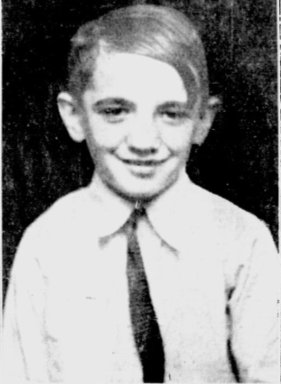
This story crossing these three individuals began in 1931 when Steve Zientek began committing petty crimes and runs its course through the 1934 Auto-Lite Strike and involved both an investigation by National Guard leaders and the Lucas County Coroner, Frank G. Kreft. This is where Stephen Ciygon comes in and how it came to light that quite possibly Steve Zientek murdered both Eddie Baginski and Stephen Cyigon. Steve Zientek’s story ended with a 10-15 year sentence in the Mansfield Reformatory.
Steve Zientek was a young man not quite 16 years old in 1931, living with his mother on Streicher St.
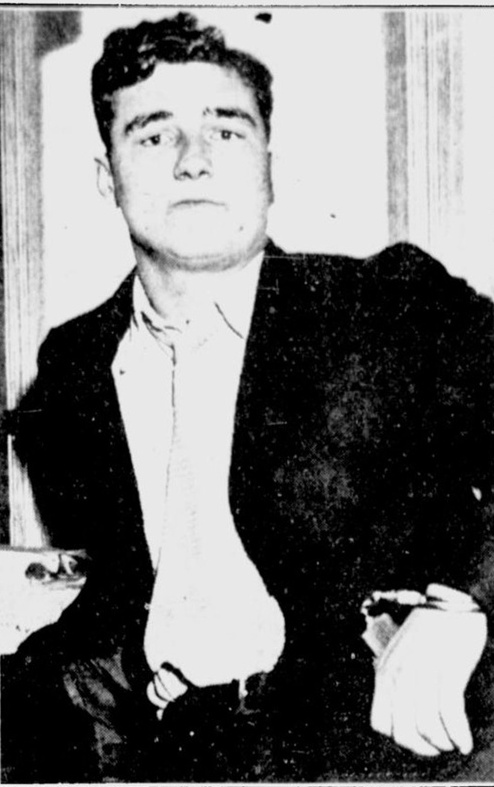
Eddie Baginski was the son of Casimier and Kamila Babrowski, born 26 June 1919. He was baptized Apolinary but was known as Eddie. The family resided on Weber street. Eddie was not quite 12 years old when he lost his life in 1931.
Cyigon was a young man of Hungarian descent who resided with his mother in Rossford.
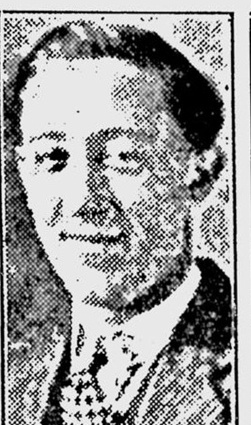
On 23 April 1931 Eddie Baginski did not return home from school. The family called police to report him missing after they initially searched the area. Eddie’s sister, Mrs. Leocadia Kwiatkowski gave an interview in 1934, three years after Eddie’s death, where she stated Eddie hated water, had a fear of water, and believed he had never gone swimming.
A few weeks later, on 11 May 1931, Eddie’s body was found in Ten Mile Creek by a Frank Hentka who resided on Elm Street. Coroner Kreft held a post mortem examination and concluded there was no evidence of foul play. Police investigated claims of Eddie being beaten and located no evidence. The boy’s death was recorded as an accidental drowning. The corner later stated that two small bruises were found on Eddie’s head, no skin was broken, and that he could not determine whether the bruises were caused by blows. A Detective Hovey investigated claims that Eddie had been seen walking along Manhattan Blvd. the night of 24 April 1931. These claims were never verified.
Steve Zientek had a history of petty crimes and unusual behavior after the death of Eddie. He had been arrested for larceny a few times and in 1932, claimed to have swallowed a safety pin while being held at the Safety Building after being arrested for prowling the Kraft sweet shop on Lagrange Street. He was taken to the Lucas County Hospital for x-rays and was determined to not be in a serious condition. In January 1933, Zientek was charged with assault to rob but was turned over to juvenile authorities because he was under age. On 2 May 1934, Zientek was indicted by a grand jury on charges of robbing a gas station at Rockingham and Cherry streets on 8 April. Then on 9 June 1934, Zientek was sentenced to an indeterminate term to the Mansfield Reformatory for that holdup and another where he had stolen a cab and money from a man named Dewey Howe. Zientek was transported to the Reformatory in early August 1934.
Just prior to Zientek being sent to Mansfield, the Auto-Lite strike was raging. This strike was violent and riots broke out. National Guard Troops were brought into Toledo and the Auto-Lite Plant was shutdown. On 24 May 1934 what was called the “Battle of Chestnut Hill” erupted around the Auto-Lite Plant near Elm St. and Michigan St. The National Guard attempted to quell rioting by shooting into the mobs surrounding the Auto-Lite plant. Two men were killed: Stephen Cyigon and Frank Hubay. It during this riot that Zientek claimed he shot Stephen Cyigon to death.
“Sincere regret” was expressed by Brigadier General Connelly regarding the bloodshed, as he believed that that two men, Cyigon and Hubay, were shot and killed by guardsmen.
After arriving at Mansfield, Zientek claimed to have been tormented by his conscience and confessed to the superintendent of the Mansfield Reformatory that he had killed Stephen Cyigon during the riots and also claimed to have clubbed and drowned Eddie Baginski. Zientek was then brought back to Toledo to be interviewed by Detectives John Hovey and Ralph Murray of the homicide squad. The story of his confessions was published in the News Bee on 17 August 1931.
In his confessions, Zientek claimed Cyigon was a rival for a girl’s attention. The two had a fistfight over a girl in a dance hall a few days before the rioting. Zientek said he was in the rioting crowds with a .45 automatic in his pocket that was loaded with steel jacketed bullets, resembling military bullets. Zientek stated he spotted Ciygon, and shot him, and later threw the gun in the Maumee River. He stated he felt that the crime would go undetected because of the mayhem going on during these riots–National Guardsmen were firing at strikers and strikers were throwing bricks and rocks.
Zientek then confessed that he killed Eddie in 1931 because the “boy had been stealing junk” from his home. So he said he whittled out a club from a tree limb on 24 April and took Eddie to a picture show downtown. The two then took a walk along Ten Mile Creek after the show. He claimed to have clubbed Eddie at the creek and pushed him into the water, watching Eddie pray in Polish as he sank into the water.
Coroner Kreft ordered Eddie Baginski’s to be exhumed and stated he would perform a full autopsy. The autopsy was witnessed by Eddie’s sister, Leocadia Kwiatkowski. She and her mother maintained that Eddie was murdered. Mrs. Kwiatkowski stated that Eddie was last seen alive on 24 April 1931, when he came home from school for lunch. He left after having lunch. In an interview published in the Toledo News Bee on 18 August 1934, Mrs. Kwiatkowski further stated that “a little boy came to the house and told my mother she would never see Edward again, that he had been drowned. He said some big boys that he didn’t know had been talking about it and he overheard it from them.”
Mrs. Kwiatkowski went on further stating that “we charged he (Kreft) had failed to make a proper investigation, he told us to get out of his office and not bother him. We feel certain Edward never went to the creek voluntarily. He hated water. Altho (sic) he was 12, he never had been in swimming.”
Investigations were launched into Zientek’s claims for a grand jury to review the evidence for both cases.
During the police investigations for both crimes, police could not connect Zientek to either Eddie or Cyigon. Zientek lived on E. Streicher Street, the Baginski family lived on E. Weber. Their homes were about a mile apart; however, friends and witnesses claimed that Zientek did not know the Baginski family nor was he known to have socialized or visit with the Baginski family. Cyigon’s friends and family said Cyigon had no interest in dancing and was not known to frequent dance halls. Additionally, Cyigon lived on Oak St. in Rossford, so it was highly unlikely Zientek and Cyigon would have been well acquainted and their alleged meeting in a dance hall would have been very brief.
At 1122 Michigan St., a large gash torn from a wooden wall of a grocery store was found where Stephen Cyigon was killed. The bullet believed to kill Cyigon was found lodged in this wall.
Major Paul Ensign of the 112th medical regiment and a witness to Coroner Kreft’s inquest, stated that a study of Cyigon’s body convinced him that the fatal would could not have been caused by .30 caliber steel jacketed bullets used by the guardsmen. Additionally, a representative of the Adjutant-General introduced non-army type of bullets and shotgun shells that police gathered near the Auto-Lite plant as evidence to support a claim from guardsmen that civilians had fired shots as well as the National Guard had.
Colonel William Marlin, commander of the infantry posted to Toledo, said soldiers filed reports on the shooting and none of the reports contained clues who may have fired the fatal shots for either Cyigon or Hubay.
Police had issued a public request that anyone who may have found a .45 revolver to bring the weapon to the Safety Building to aid in checking Zientek’s confession of killing Cyigon. It seems the weapon had never been found.
Mansfield authorities believed Zientek’s confessions. These confessions were detailed: Zientek gave an account of drawling between two homes on Michigan Street, climbing over a fence, and using a concrete block porch as a gun rest, shooting Cyigon with the .45 while soldiers were firing into the rioting crowds at the intersection of Chestnut and Michigan.
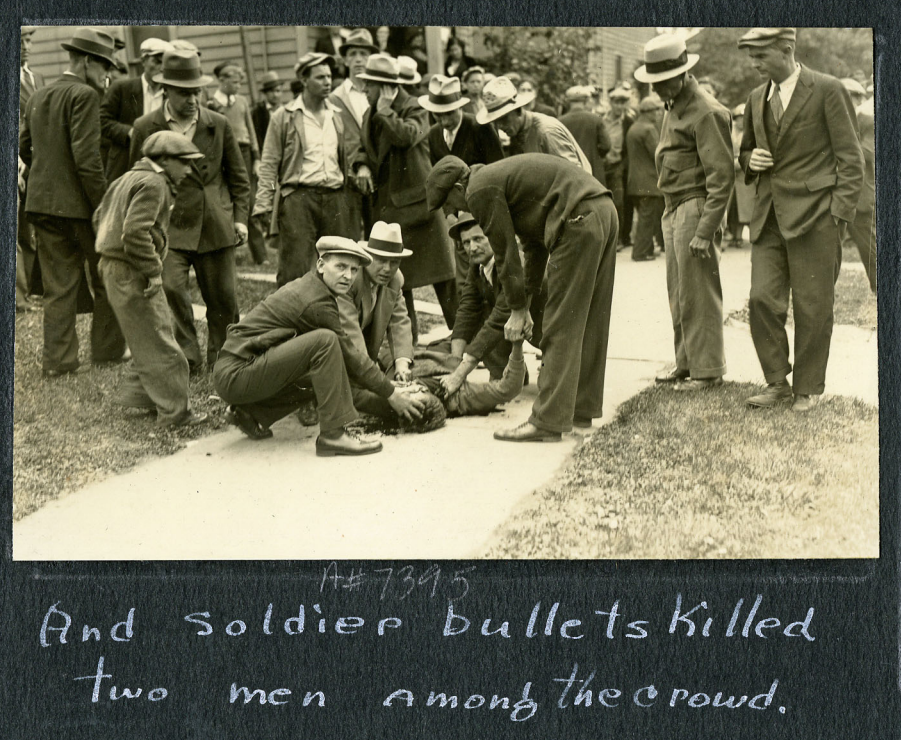
The grand jury was convened in August to hear Zientek testify and to review evidence from both murders. It was during the grand jury investigation that it was observed no one was found to testify that Zientek even knew Eddie or Cyigon. Ernest C. Miller of the Criminal Identification Bureau at Mansfield visited the scene of the riots and found it possible a man could have stood in front of a small wooden fence between the homes at 1131 and 1135 Michigan St. and fire the fatal shot diagonally across the street at Cyigon, who was standing in front of a grocery store at 1122 Michigan.
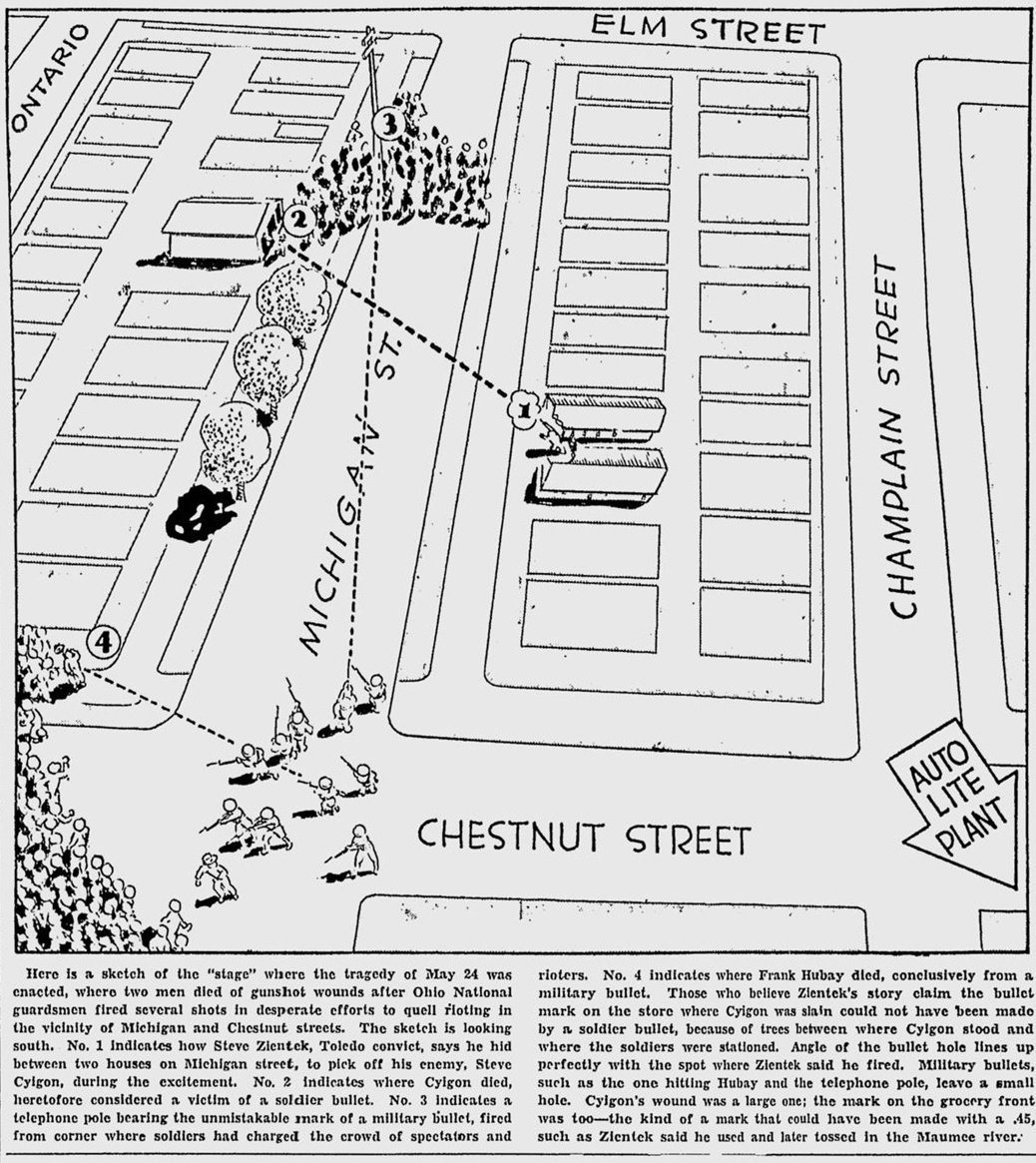
Testimony was provided by neighborhood residents that soldiers fired few shots and a .45 coming from the side of the street would have been noticed. It was contended that the bullet that killed Cyigon must have been a .45, given the size of the would. Ballistics experts challenged that contention by saying one of the high-powered steel jacketed bullets could have caused the same type and size of injury.
The grand jury returned a “no bill”–meaning they did not find enough evidence to indict Zientek on criminal charges for the deaths of Eddie Baginski and Stephen Cyigon. The jury did recommend that Zietek be placed under observation at the Reformatory to determine his sanity.
Coroner Kreft’s final findings were that Cyigon died due to hemmorhage following preformation of the carotid artery, publicly defending himself (and his insistence that Zientek was innocent of Cyigon’s death) by stating the wound in Cyigon’s neck was large, one that would have been torn by a military-style bullet. Kreft also returned a verdict of accidental drowning in the Baginski case. Kreft also recommended a mental examination of Zientek.
The Lucas County Probate Court awarded Cyigon’s family $599.15 in a wrongful death suit that charged Auto Lite with wrongful acts and neglect that caused his death. The matter was settled by awarding $450 to Stephen Cyigon’s brother, Julius, for the wrongful injuries and $149.15 to Cyigon’s mother, Meri Gyori.
Zientek served out part of his sentence at Mansfield for the original robbery charges and was released by 1940. He eventually married, had a family, and divorced. There were no further indications of any further criminal activity. He died on 31 December 1973 at the age of 58.
Did Zientek kill Eddie Baginski and Stephen Cyigon? I can’t image why one would confess to such crimes as these unless either guilty or experiencing a several mental illness. Several editorials, including a long first page editorial published in the News Bee on 23 August 1934, stated a firm belief that Zientek committed these crimes. The grand jury however, could not come up with enough conclusive evidence to indict Zientek.
1. A full high-resolution digital copy of this entire scrapbook is available from archive.org: https://archive.org/details/aalh_autolitestrikescrapbook/page/n9/mode/2up. This was made possible through the Local History and Genealogy Department of the Toledo Lucas County Public Library.
2. While researching this story, I interestingly was able to corroborate the validity of this map with a narrative I had come across from the New Masses publication dated 5 June 1934. This is a pro-Marxist publication that was produced from the late 1920s through 1940s. See https://www.marxists.org/history/usa/pubs/new-masses/1934/v11n10-jun-05-1934-NM.pdf, page 10, in an article titled “Picket Lines.”